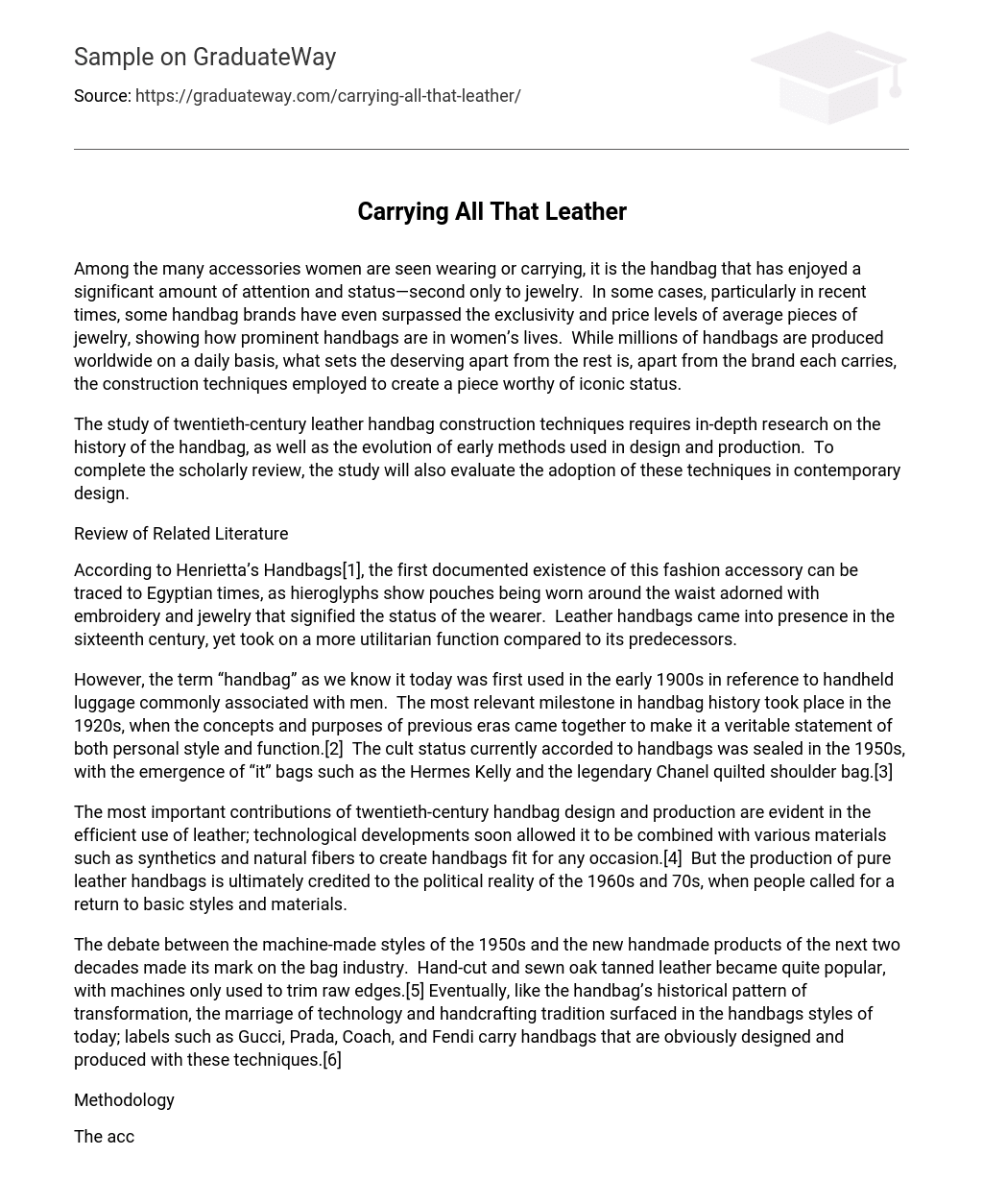Among the many accessories women are seen wearing or carrying, it is the handbag that has enjoyed a significant amount of attention and status—second only to jewelry. In some cases, particularly in recent times, some handbag brands have even surpassed the exclusivity and price levels of average pieces of jewelry, showing how prominent handbags are in women’s lives. While millions of handbags are produced worldwide on a daily basis, what sets the deserving apart from the rest is, apart from the brand each carries, the construction techniques employed to create a piece worthy of iconic status.
The study of twentieth-century leather handbag construction techniques requires in-depth research on the history of the handbag, as well as the evolution of early methods used in design and production. To complete the scholarly review, the study will also evaluate the adoption of these techniques in contemporary design.
Review of Related Literature
According to Henrietta’s Handbags[1], the first documented existence of this fashion accessory can be traced to Egyptian times, as hieroglyphs show pouches being worn around the waist adorned with embroidery and jewelry that signified the status of the wearer. Leather handbags came into presence in the sixteenth century, yet took on a more utilitarian function compared to its predecessors.
However, the term “handbag” as we know it today was first used in the early 1900s in reference to handheld luggage commonly associated with men. The most relevant milestone in handbag history took place in the 1920s, when the concepts and purposes of previous eras came together to make it a veritable statement of both personal style and function.[2] The cult status currently accorded to handbags was sealed in the 1950s, with the emergence of “it” bags such as the Hermes Kelly and the legendary Chanel quilted shoulder bag.[3]
The most important contributions of twentieth-century handbag design and production are evident in the efficient use of leather; technological developments soon allowed it to be combined with various materials such as synthetics and natural fibers to create handbags fit for any occasion.[4] But the production of pure leather handbags is ultimately credited to the political reality of the 1960s and 70s, when people called for a return to basic styles and materials.
The debate between the machine-made styles of the 1950s and the new handmade products of the next two decades made its mark on the bag industry. Hand-cut and sewn oak tanned leather became quite popular, with machines only used to trim raw edges.[5] Eventually, like the handbag’s historical pattern of transformation, the marriage of technology and handcrafting tradition surfaced in the handbags styles of today; labels such as Gucci, Prada, Coach, and Fendi carry handbags that are obviously designed and produced with these techniques.[6]
Methodology
The accuracy in the observation of handbag construction development may be gleaned primarily from an evaluation of perceivable similarities and differences between one produced in the early twentieth century and one just off a famous brand’s recent collection. An observation guide is recommended, mainly to note the clear construction qualities of both handbag classifications. Interviews with designers and handbag-makers, representing the two eras, should be part of the study for they are bound to be informative sources in this activity.
Bibliography
- Accesoryweb, ‘History of the Handbag’, 1997, retrieved 09 November 2008, http://www.accessoryweb.com/history.html
- Clarke, A, ‘Leather Handbags-Luxurious and Costly’, eZine Articles, 2008, retrieved 09 November 2008, http://ezinearticles.com/?Leather-Handbags—Luxurious-and-Costly&id=1388781
- Gleni, ‘The Handbag in History’, 2003-2008, retrieved 08 November 2008, http://www.gleni.it/bag-in-history.html
- Henrietta’s Handbags & Purse Patterns, ‘A History of Handbags’, 2001-2008, retrieved 09 November 2008, http://henriettashandbags.com/a_history_of_handbags.html
- Henry H, ‘Leather Goods Design Considerations’, Leather Goods Connection, 2008, retrieved 08 November 2008, http://home.alltel.net/henryh/Design.html





